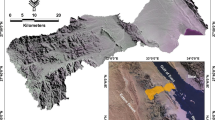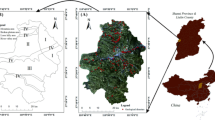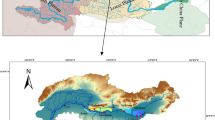Abstract
With the frequent occurrence of natural disasters, timely warning of flood disasters has become an issue of concern. This research mainly discusses flood disaster risk assessment based on random forest algorithm. This study uses the special functions of GIS to collect, manage, and analyze data to propose a method of flood disaster risk assessment based on GIS. This method is based on the characteristics of natural disaster-causing factors in the study area, selects an appropriate grid size, and finally realizes the function of visual expression of regional disaster risk. First, use ArcGIS10.1 to analyze and integrate each hazard factor into the flood disaster report index model. Second, the random forest algorithm is used as the weight of each parameter of the flood disaster index model. Finally, use ArcGIS spatial analysis tool map algebra function to model, carry out flood risk assessment in different periods, and use spatial analysis function to extract the median value to point function to extract the flood inundation depth of the study area in a specific scenario. In the experimental part, this research uses layer overlay to determine the number and types of affected areas. Using the natural break point method of ArcGIS 10.1 platform, the study area is divided according to the magnitude of the flood disaster risk value. At the same time, there are a total of 85 samples that have experienced flood disasters, of which only six have been misjudged as no flood disasters. Generally speaking, the model prediction accuracy is high. The research results show that the combination of random forest algorithm and GIS technology is convenient for analyzing the spatial pattern and internal laws of flood risk, and has good applicability.




Similar content being viewed by others
Explore related subjects
Discover the latest articles and news from researchers in related subjects, suggested using machine learning.References
Polan D, Brady S, Kaufman R (2016) Tissue segmentation of computed tomography images using a Random Forest algorithm: a feasibility study. Med Phys 43(6):3330–3331
Xu Y, Zhang J, Gong X et al (2016) A method of real-time traffic classification in secure access of the power enterprise based on improved random forest algorithm. Power Syst Protect Control 44(24):82–89
Joshuva A, Sugumaran V (2017) Fault diagnosis for wind turbine blade through vibration signals using statistical features and random forest algorithm. Int J Pharm Technol 9(1):28684–28696
He S, Chen W, Liu H et al (2019) Gene pathogenicity prediction of Mendelian diseases via the random forest algorithm. Hum Genet 138(6):673–679
Wang Y, Xia H, Yuan X et al (2018) Distributed defect recognition on steel surfaces using an improved random forest algorithm with optimal multi-feature-set fusion. Multimed Tools Appl 77(13):16741–16770
Mohammady M, Pourghasemi HR, Amiri M (2019) Land subsidence susceptibility assessment using random forest machine learning algorithm. Environ Earth Sci 78(16):1–12
Guo J, Wang J, Li Q et al (2019) Construction of prediction model of neural network railway bulk cargo floating price based on random forest regression algorithm. Neural Comput Appl 31:8139–8145
Rewade AD, Mohod SW (2018) Content based alternate medicine recommendation by using random forest algorithm a review. Int J Comput Sci Eng 6(10):770–775
Wu Q, Wang H, Yan X et al (2019) MapReduce-based adaptive random forest algorithm for multi-label classification. Neural Comput Appl 31:8239–8252
Zhang X, Huang W, Lin X et al (2020) Complex image recognition algorithm based on immune random forest model. Soft Comput 24:12643–12657
Levantesi S, Nigri A (2020) A random forest algorithm to improve the Lee–Carter mortality forecasting: impact on q-forward. Soft Comput 24:8553–8567
Rewade AD, Mohod SW, Bargat SP (2019) Content based alternate medicine recommendation by using random forest algorithm. Int J Comput Sci Eng 7(4):1163–1168
Lin P, Yang L (2019) Urban classification based on random forest algorithm. Int J Adv Res 7(11):844–849
Zhang Q, Sun X, Feng K et al (2017) Predicting citrullination sites in protein sequences using mRMR method and random forest algorithm. Comb Chem High Throughput Screen 20(2):164–173
Shevchik SA, Saeidi F, Meylan B et al (2017) Prediction of failure in lubricated surfaces using acoustic time-frequency features and random forest algorithm. IEEE Trans Industr Inf 13(4):1541–1553
Kim A, Myung J, Kim H (2020) Random forest ensemble using a weight-adjusted voting algorithm. J Korean Data Inf Sci Soc 31(2):427–438
Chen J, Li K, Tang Z et al (2017) A parallel random forest algorithm for big data in a spark cloud computing environment. IEEE Trans Parallel Distrib Syst 28(4):919–933
Li N, Cheng X, Guo H et al (2016) Recognizing human interactions by genetic algorithm-based random forest spatio-temporal correlation. Pattern Anal Appl 19(1):267–282
Bharati S, Podder P, Paul PK (2019) Lung cancer recognition and prediction according to random forest ensemble and RUSBoost algorithm using LIDC data. Int J Hybrid Intell Syst 15(2):91–100
Wang Y, Li T (2018) Improving semi-supervised co-forest algorithm in evolving data streams. Appl Intell 48:3248–3262
Xue L, Wang L (2018) Video tracking algorithm based on particle filter and online random forest. Wirel Pers Commun 102:3725–3735
Yao D, Zhan X, Kwoh CK (2019) An improved random forest-based computational model for predicting novel miRNA-disease associations. BMC Bioinform 20:624
Kumar S, Sahoo G (2017) A random forest classifier based on genetic algorithm for cardiovascular diseases diagnosis. Int J Eng Trans B 30(11):1723–1729
Cao Y, Fan X, Guo Y et al (2020) Multi-objective optimization of injection-molded plastic parts using entropy weight, random forest, and genetic algorithm methods. J Polym Eng 40(4):360–371
Peng X, Li J, Wang G et al (2019) Random forest based optimal feature selection for partial discharge pattern recognition in HV cables. IEEE Trans Power Deliv 34(4):1715–1724
Song J, Li C, Zheng C et al (2017) MetalExplorer, a bioinformatics tool for the improved prediction of eight types of metal-binding sites using a random forest algorithm with two-step feature selection. Curr Bioinform 12(6):480–489
Acknowledgements
This work was supported by the Special Projects in Key Areas (New Generation of Information Technology) of Colleges and Universities in Guangdong Province (2020ZDZX3046), the Characteristics innovation project of colleges and universities of Guangdong Province (Natural Science, No. 2019KTSCX235, 2019), and the Higher Education of the Ministry of Education of the People’s Republic of China has the first batch of “industry-academic cooperation, collaborative education” projects in 2019 (No. 201901070016), Characteristic Innovation Projects of Guangdong Province Education Program (2018KTSCX209, 2019GKTSCX092); Science and Technology Program of Guangdong Province (2020B121201013); Science and Technology Special Fund Program of Guangdong Province (2020A0102009); Rural Science and Technology Commissioner Program of Guangdong Province (KTP20200278); Collaborative Innovation Center of Big Data Research and Application, JYU and GMIP (130B0310); Research Achievement Award Cultivation Project, Jiaying University. The Special Projects in Key Areas (New Generation of Information Technology) of Colleges and Universities in Guangdong Province (CN) (Grant No. 2020ZDZX3046).
Author information
Authors and Affiliations
Corresponding author
Ethics declarations
Conflict of interest
These no potential competing interests in our paper. And all authors have seen the manuscript and approved to submit to your journal. We confirm that the content of the manuscript has not been published or submitted for publication elsewhere.
Additional information
Publisher's Note
Springer Nature remains neutral with regard to jurisdictional claims in published maps and institutional affiliations.
Rights and permissions
About this article
Cite this article
Zhu, Z., Zhang, Y. Flood disaster risk assessment based on random forest algorithm. Neural Comput & Applic 34, 3443–3455 (2022). https://doi.org/10.1007/s00521-021-05757-6
Received:
Accepted:
Published:
Issue Date:
DOI: https://doi.org/10.1007/s00521-021-05757-6




